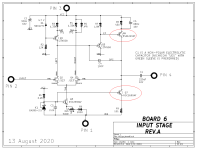It works and it's wonderful!!
Just another testimony. I started the project with Teabag's boards a few years back and wound up setting it aside because... life. When I returned to it the build was a bit nerve-wracking and long, mostly because I'm a noob - I'd only built an ACA when I started this project and that's MUCH easier. The M2 is driving Tannoys at the moment, and I'm a little surprised at how much it bests my beloved tube amps (and the ACA). I'm also surprised at what it gets out of the Tannoys - they're not exactly perfect speakers. Much gratitude to Mr. Pass and Teabag.
Just another testimony. I started the project with Teabag's boards a few years back and wound up setting it aside because... life. When I returned to it the build was a bit nerve-wracking and long, mostly because I'm a noob - I'd only built an ACA when I started this project and that's MUCH easier. The M2 is driving Tannoys at the moment, and I'm a little surprised at how much it bests my beloved tube amps (and the ACA). I'm also surprised at what it gets out of the Tannoys - they're not exactly perfect speakers. Much gratitude to Mr. Pass and Teabag.
A quick question about the Cedarburg card.
Since I have most of the parts on hand, including the AD797 and PCBs, I thought I'd solder up a pair of the Cedarburg boards and try them as a standalone buffer preamp. No plans on changing unity gain on the board; the idea (such as it is) is to compare with two other buffer preamps I made, one using 2SK170 / 2SJ74 as in ZM's Iron Pre (https://www.diyaudio.com/community/threads/whats-wrong-with-the-kiss-boy.293169/) the other using tombo56's design (https://www.diyaudio.com/community/...similar-amplifiers.382345/page-4#post-6946565). These are my two favourite preamps presently, and it seemed like fun to try Cedarburg in a similar way; if I can get my hands on 600:600 transformers I may try them (like in ZM's thread) with the Cedarburgs to give some gain, which seems quite similar to their intended purpose in the M2X.
Anyway, my question is about a substitution. The only parts I'm missing are D44H11 and D45H11, which I can't find at the usual places (I usually use Mouser or Digikey). I'm not an EE, but to my layman's eyes the KSE44H11 looks pretty much the same as DH4411:
https://www.mouser.com/datasheet/2/308/1/KSE44H_D-1810380.pdf
and the D45H11FP
https://www.mouser.com/datasheet/2/389/d45h11fp-1848986.pdf
seems to be the same as the D45H11 but in a different package. (Maybe heat issues if totally plastic case?) Any problem with substituting these for the D44H11/D45H11? If so then another alternative might be the D-PAK models
https://www.mouser.com/datasheet/2/308/1/MJD44H11_D-1811546.pdf
which I'm guessing are just the SMD versions of the equivalents. They'd need some kind of diy heatsink/adapter arrangement, but that might be a fun challenge...
Many thanks for any input.
Since I have most of the parts on hand, including the AD797 and PCBs, I thought I'd solder up a pair of the Cedarburg boards and try them as a standalone buffer preamp. No plans on changing unity gain on the board; the idea (such as it is) is to compare with two other buffer preamps I made, one using 2SK170 / 2SJ74 as in ZM's Iron Pre (https://www.diyaudio.com/community/threads/whats-wrong-with-the-kiss-boy.293169/) the other using tombo56's design (https://www.diyaudio.com/community/...similar-amplifiers.382345/page-4#post-6946565). These are my two favourite preamps presently, and it seemed like fun to try Cedarburg in a similar way; if I can get my hands on 600:600 transformers I may try them (like in ZM's thread) with the Cedarburgs to give some gain, which seems quite similar to their intended purpose in the M2X.
Anyway, my question is about a substitution. The only parts I'm missing are D44H11 and D45H11, which I can't find at the usual places (I usually use Mouser or Digikey). I'm not an EE, but to my layman's eyes the KSE44H11 looks pretty much the same as DH4411:
https://www.mouser.com/datasheet/2/308/1/KSE44H_D-1810380.pdf
and the D45H11FP
https://www.mouser.com/datasheet/2/389/d45h11fp-1848986.pdf
seems to be the same as the D45H11 but in a different package. (Maybe heat issues if totally plastic case?) Any problem with substituting these for the D44H11/D45H11? If so then another alternative might be the D-PAK models
https://www.mouser.com/datasheet/2/308/1/MJD44H11_D-1811546.pdf
which I'm guessing are just the SMD versions of the equivalents. They'd need some kind of diy heatsink/adapter arrangement, but that might be a fun challenge...
Many thanks for any input.
Finally, I've built all 8 daughter boards.
Thanks all of you, special to Mark Johnson.
I've made the test jig circuit by Mark Johnson but did Idss matching for J113 of IPS6.
Fortunately, I could get 2 pairs from 24 pieces.
My system is a near field PC(desk)-fi like below.
PC Tidal source -> Savitech USB driver coaxial output -> Soekris dam1021 R2R DAC (1.4Vrms raw output without output buffer) -> Wayne's 2018 linestage + Muses 72323 Digital Volume control -> M2x -> SoundArtist LS3/5A speaker
Ishikawa - some weird sound character on my system. The center imaging is far below of my desk. I don't know why.
Mountain View - It has so strong its own sound character. so a very wide soundstage. rich and full body sound. so full feeling musical presentation.
Tucson - with OPA1611. easy listening.
Austin - I can’t find any pitfall.
Norwood - very clean and super mid high freq detail but narrow soundstage and no bass.
IPS6 - They say that the sonic character seems like Norwood.
It’s definitely not similar to Norwood.
It is superior than all others daughter boards in all about sound aspects - wide soundstage, better instrument seperation, more transparant, superb 3d imaging, super super super details, musicality.and controlled bass.
It makes M2x as another upper level amplifier.
I could not hear so great sound before on my humble system. WOW!!!!
It’s so good to me.
IPS7 - They say that LT1121 opamp sounds so good. Detail and HF is so good but on mid, mid-high it feels some muddy. With LME49720 it sounds better, well balanced.
Cedarburg (IPS8) - I can find some peace of mind. The depth is very narrow but the sound is so silky, well balanced, not fatiguing and easy listening for a long time.
Thanks all of you, special to Mark Johnson.
I've made the test jig circuit by Mark Johnson but did Idss matching for J113 of IPS6.
Fortunately, I could get 2 pairs from 24 pieces.
My system is a near field PC(desk)-fi like below.
PC Tidal source -> Savitech USB driver coaxial output -> Soekris dam1021 R2R DAC (1.4Vrms raw output without output buffer) -> Wayne's 2018 linestage + Muses 72323 Digital Volume control -> M2x -> SoundArtist LS3/5A speaker
Ishikawa - some weird sound character on my system. The center imaging is far below of my desk. I don't know why.
Mountain View - It has so strong its own sound character. so a very wide soundstage. rich and full body sound. so full feeling musical presentation.
Tucson - with OPA1611. easy listening.
Austin - I can’t find any pitfall.
Norwood - very clean and super mid high freq detail but narrow soundstage and no bass.
IPS6 - They say that the sonic character seems like Norwood.
It’s definitely not similar to Norwood.
It is superior than all others daughter boards in all about sound aspects - wide soundstage, better instrument seperation, more transparant, superb 3d imaging, super super super details, musicality.and controlled bass.
It makes M2x as another upper level amplifier.
I could not hear so great sound before on my humble system. WOW!!!!
It’s so good to me.
IPS7 - They say that LT1121 opamp sounds so good. Detail and HF is so good but on mid, mid-high it feels some muddy. With LME49720 it sounds better, well balanced.
Cedarburg (IPS8) - I can find some peace of mind. The depth is very narrow but the sound is so silky, well balanced, not fatiguing and easy listening for a long time.
Attachments
-
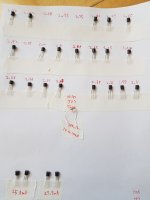 20230408_143426 (1).jpg226 KB · Views: 187
20230408_143426 (1).jpg226 KB · Views: 187 -
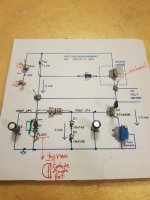 20230405_234520 (1).jpg285.3 KB · Views: 188
20230405_234520 (1).jpg285.3 KB · Views: 188 -
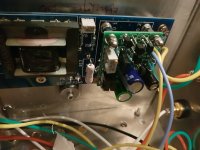 20230408_193218 (1).jpg287.1 KB · Views: 195
20230408_193218 (1).jpg287.1 KB · Views: 195 -
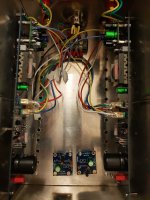 20230408_193727 (1).jpg348.5 KB · Views: 168
20230408_193727 (1).jpg348.5 KB · Views: 168 -
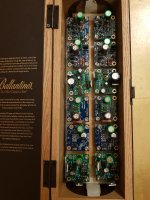 20230408_193309 (1).jpg481.4 KB · Views: 167
20230408_193309 (1).jpg481.4 KB · Views: 167 -
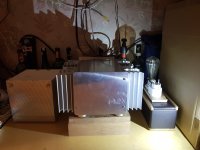 20230412_225954.jpg378.4 KB · Views: 162
20230412_225954.jpg378.4 KB · Views: 162 -
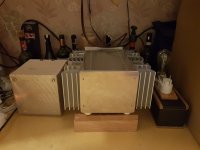 20230412_230041.jpg328.7 KB · Views: 173
20230412_230041.jpg328.7 KB · Views: 173
Congratulations on successfully building an M2x and eight different input stage circuits!! I'm sure other M2x owners (and potential M2x builders) will be very thankful for your listening impressions of their sonic character.
Fantastic job, lovely build, good on ya!
-- Mark Johnson
Fantastic job, lovely build, good on ya!
-- Mark Johnson
@namghiwook What a wonderful project! Very well done and congratulations!
👏 👏 👏
I must mention, I think you are the ONLY builder to have built all 8 of the cards (Aside Mark, of course…) what a fantastic process it must have been! Having the ability, time, and opportunity to thoughtfully compare all the cards is great fun, thank you for sharing your observations.
👏 👏 👏
I must mention, I think you are the ONLY builder to have built all 8 of the cards (Aside Mark, of course…) what a fantastic process it must have been! Having the ability, time, and opportunity to thoughtfully compare all the cards is great fun, thank you for sharing your observations.
It is definitely good to hear other builders' impressions on the different M2x input stages. Sometimes I wonder if I am crazy for having such strong preferences myself. My personal faves were the Mtn View (with voltage reference in place of red LED) and Austin. I liked Austin so much that I replaced the stock front end in my F6 with a tweaked version; TTC004B and TTA004B as output transistors to drive the Jensen signal transformer.
There are certainly differences in the input stages… I strongly prefer IPS6 and Norwood, followed closely by Mountian View. I have not actually built Austin and now am even more curious from these most recent comments.
The thing worth repeating is that there are no “bad” input stages and they all work perfectly and each sounds very good - however some sound ‘better’ in a way that’s hard to describe other than I like it more.
The M2 output stage is responsible for the vast majority of the sonic signature of the amplifier, I personaly would be quite content with any of the input cards.
(But there’s a 6 in mine currently)
😎
The thing worth repeating is that there are no “bad” input stages and they all work perfectly and each sounds very good - however some sound ‘better’ in a way that’s hard to describe other than I like it more.
The M2 output stage is responsible for the vast majority of the sonic signature of the amplifier, I personaly would be quite content with any of the input cards.
(But there’s a 6 in mine currently)
😎
You’ve motivated me to swap out my input cards. I haven’t removed my first one yet (ishikawa) because it sounds so good. Been playing it 10 hours a day for 3 months now and still love it. Mtn view is next, and I finally received the back ordered chip to finish Norwood.
Question: did you notice a break in period for each card each time you changed them?
Question: did you notice a break in period for each card each time you changed them?
caps need an hour to form electrolite....“Break in” exists in your auditory system, not in the electronics.
I've seen this several times now with positive commentary when people use these parts in that sort of role, they must be pretty good. Successful in the BA2018 OS too. I have some coming soon to try out in my follower stage to drive the autoformer in my signature. My current configuration has BJT's with some beta droop at the higher current levels (according to datasheet), the Toshibas won't have that problem where I plan to run them. I have a laundry list of things I'm going to tweak, the new transistors being one of the main things.TTC004B and TTA004B as output transistors to drive the Jensen signal transformer.
Maybe “Burn-in” is a better word. Or opening up. I’ve noticed a difference in sound that improves over the course of about 100 hours which seems to
6l6 - when you say auditory system not electronics, are you talking about my ears?
6l6 - when you say auditory system not electronics, are you talking about my ears?
The wonderful Fairchild KSC2590A / KSA1220A complementary pair, is (in my opinion anyway) preferable to the Toshiba TTC004B/TTA004B pair. Unfortunately, ONsemi/Fairchild discontinued the PNP a year or two ago, forcing DIY builders into the arms of Toshiba. But if you've got a stash of the Fairchilds, give them a try, I think you'll be delighted.
_
_
Attachments
Thanks Mark, I think I may actually have some of those. I need to verify. That part does look really good. The KSC3503 I'm using are probably much more at home in the VAS stage.
What's different about the IPS6 daughter card? {maybe that might partly explain why it sounds good, in some listeners' opinion?}
IPS6 is a transconductance ampifier, a voltage controlled current source, with a very high output impedance, driving a step up transformer. This is a bit unconventional, usually power amp front end circuits are voltage controlled voltage source amplifiers, with very low output impedance. Other front ends using the transconductance topology include Dreadnought and Kitty Hawk. Both of them drive a step up transformer, just like IPS6.
And finally, Lexington is a transconductance amp, operated from a DC-to-DC voltage boosted power supply, so it omits the step up transformer entirely. Lexington's transconductance amp directly drives the power amp output stage.
note: Dreadnought, Kitty Hawk, and Lexington are front ends for a different, non-M2x power amplifier, called "Ship Of Theseus". S.O.T. divides the amplification job among two circuit boards (same as M2x), namely Front End and Output Stage. The physical circuit boards are not interchangeable between M2x and Ship Of Theseus, but the design ideas have a lot of commonality.
IPS6 is a transconductance ampifier, a voltage controlled current source, with a very high output impedance, driving a step up transformer. This is a bit unconventional, usually power amp front end circuits are voltage controlled voltage source amplifiers, with very low output impedance. Other front ends using the transconductance topology include Dreadnought and Kitty Hawk. Both of them drive a step up transformer, just like IPS6.
And finally, Lexington is a transconductance amp, operated from a DC-to-DC voltage boosted power supply, so it omits the step up transformer entirely. Lexington's transconductance amp directly drives the power amp output stage.
note: Dreadnought, Kitty Hawk, and Lexington are front ends for a different, non-M2x power amplifier, called "Ship Of Theseus". S.O.T. divides the amplification job among two circuit boards (same as M2x), namely Front End and Output Stage. The physical circuit boards are not interchangeable between M2x and Ship Of Theseus, but the design ideas have a lot of commonality.
The comment that Norwood has no bas?
If this is a pure objective observation then the input card has an error.
I would perform a sweep from 20 Hz to 20 kHz to very if card has a problem?
If this is a pure objective observation then the input card has an error.
I would perform a sweep from 20 Hz to 20 kHz to very if card has a problem?
I you have Tidal (HiFi agreement so you get it in hi-res) then try this track:
Then crank it up with Norwood. If no bass then "no good" 🙂
- Home
- Amplifiers
- Pass Labs
- The diyAudio First Watt M2x
